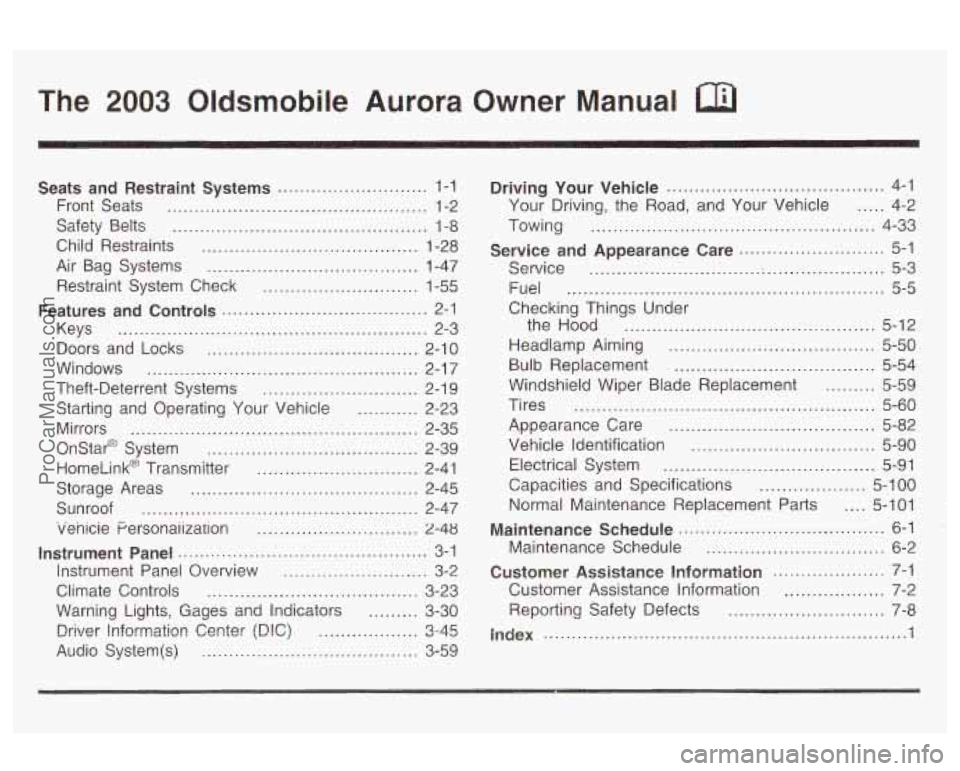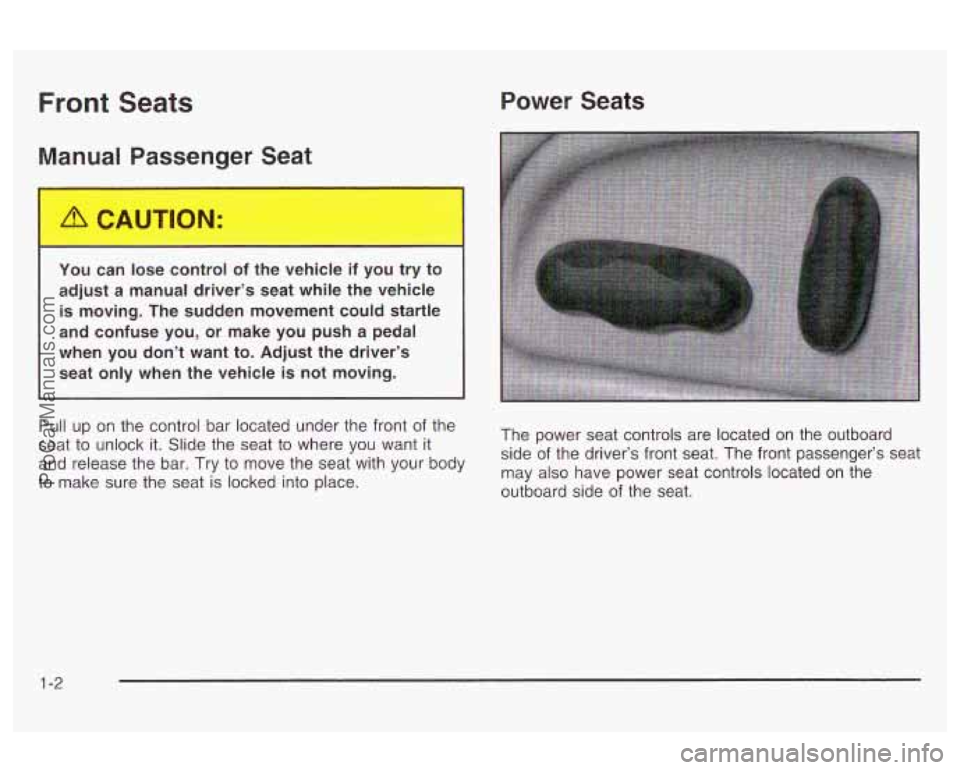lock OLDSMOBILE AURORA 2003 Owners Manual
[x] Cancel search | Manufacturer: OLDSMOBILE, Model Year: 2003, Model line: AURORA, Model: OLDSMOBILE AURORA 2003Pages: 387, PDF Size: 18.05 MB
Page 2 of 387

The 2003 Oldsmobile Aurora Owner Manual
Seats and Restraint Systems ........................... 1-1
Front Seats
............................................... 1-2
Safety Belts
.............................................. 4 -8
Child Restraints
....................................... 1-28
Air Bag Systems
...................................... 1-47
Restraint System Check
............................ 1-55
Features and Controls ..................................... 2-1
Keys
........................................................ 2-3
Doors and Locks
...................................... 2-10
Windows
................................................. 2-1 7
Theft-Deterrent Systems ............................ 2-1 9
Starting and Operating Your Vehicle
........... 2-23
Mirrors
.................................................... 2-35
Onstar@ System
...................................... 2-39
HomeLink@ Transmitter
............................. 2-41
Storage Areas
......................................... 2-45
Sunroof
.................................................. 2-47
venicie Personaiization
............................. 2-48
Instrument Panel ............................................. 3-1
Instrument Panel Overview
.......................... 3-2
Climate Controls
...................................... 3-23
Warning Lights, Gages and Indicators
......... 3-30
D!%%?r !!?formatior! Center (D!C) .................. u 12-AK -rJ
Audio System(s) ....................................... 3-59 Driving
Your Vehicle
....................................... 4-1
Your Driving. the Road. and Your Vehicle
..... 4-2
Service and Appearance Care
.......................... 5-1
Towing
................................................... 4-33
Service
............................... ;. .................... 5-3
Fuel
......................................................... 5-5
Checking Things Under
the Hood
............................................. 5-12
Headlamp Aiming
..................................... 5-50
Windshield Wiper Blade Replacement
= ~ iI I I 5-59
Tires ...................................................... 5-60
Appearance Care
..................................... 5-82
Vehicle Identification
................................. 5-90
Electrical System
...................................... 5-91
Capacities and Specifications
................... 5-1 00
Maintenance Schedule ..................................... 6-1
Maintenance Schedule ................................ 6-2
Customer Assistance Information
.................... 7-1
Customer Assistance Information
.................. 7-2
Bulb
Replacement
.................................... 5-54
Normal Maintenance Replacement Parts
.... 5-101
Reporting Safety Defects
............................ 7-8
I-- -I ~ a lnQex ................................................................. 1
ProCarManuals.com
Page 9 of 387

Front Seats
Manual Passenger Seat Power Seats
You can lose control of the vehicle if you try to
adjust a manual driver’s seat while the vehicle
is moving. The sudden movement could startle
and confuse you, or make you push
a pedal
, when you don’t want to. Adjust the driver’s
’ seat only when the vehicle is not moving.
~ I I
Pull up on the control bar located under the front of the
seat to unlock it. Slide the seat to where you want it
and release the bar. Try
to move the seat with your body
to make sure the seat is locked into place. The power
seat controls are located on the outboard
side of the driver’s front seat. The front passenger’s seat
may also have power seat controls located on the
outboard side of the seat.
1-2
ProCarManuals.com
Page 12 of 387

Heated Seats
If your vehicle has this
option, the heated seat
switch is located next
to the console shifter.
Push the
ON part of the switch once for a HI setting or
twice for a LO setting. Push the OFF part of the
switch to turn the heated seat
off. The LO setting warms
the seatback and cushion until the seat approximates
body temperature. The
HI setting heats the seatback
and cushlon to a srightiy nigner temperature.
The heated seats can only be used when the ignition is
turned on. When the ignition is turned
off, the heating
element is also turned
off.
Reclining Seatbacks
If your vehicle has a power
recliner, the vertical control
described previously in
this section reclines
the front seatbacks.
If your vehicle has the manual recliner, lift the lever on
the outboard side of the seat and move the seatback
to the desired position. Release the lever to lock
the seatback. Pull up on the lever without pushing on
the seatback and the seatback will go to an upright
position.
1-5
ProCarManuals.com
Page 21 of 387

Driver Position
This part describes the driver’s restraint system.
Lap-Shoulder Belt
The driver has a lap-shoulder belt. Here’s how to wear it
properly.
1. Close and lock the door.
2. Adjust the seat so you can sit up straight. To see
how, see “Seats” in the Index.
3. Pick up the latch plate and pull the belt across you.
Don’t let
it get twisted.
The lap-shoulder belt may lock
if you pull the belt
across you very quickly. If this happens, let the belt
go back slightly to unlock it. Then pull the belt
across you more slowly.
1-14
ProCarManuals.com
Page 22 of 387

4. Push the latch plate into the buckle until it clicks.
Puli up on the latch plate to make sure it is
secure.
If the belt isn’t long enough, see Safety
Belt Extender on
page 1-27.
Make sure the release button on the buckle is
positioned so you would be able to unbuckle the
safety belt quickly
if you ever had to. The
lap part of the belt should be worn low and snug on
the hips, just touching the thighs.
In a crash, this
applies force to the strong pelvic bones. And you’d be
less likely to slide under the lap belt.
If you slid under it,
the belt would apply force at your abdomen. This
could cause serious or even fatal injuries. The shoulder
belt should go over the shoulder and across the
chest. These parts of the body are best able to take belt
restraining forces.
The safety belt locks
if there’s a sudden stop or crash,
or if you pull the belt very quickly out of the retractor.
1-15
ProCarManuals.com
Page 28 of 387

The best way to protect the fetus is to protect the
mother. When a safety belt is worn properly, it’s more
likely that the fetus won’t be hurt in a crash. For
pregnant women, as for anyone, the key to making
safety belts effective is wearing them properly.
Right Front Passenger Position
To learn how to wear the right front passenger’s safety
belt properly, see
Driver Position on page 7-74.
The right front passenger’s safety belt works the same
way as the driver’s safety belt
- except for one
thing.
If you ever pull the lap portion of the belt out all
the way, you will engage the child restraint locking
feature. If this happens, just let the belt go back
all the
way and start again.
Rear Seat Passengers
It’s very important for rear seat passengers to buckle
up! Accident statistics show that unbelted people in the
rear seat are hurt more often in crashes than those
who are wearing safety belts.
Rear passengers who aren’t safety belted can be
thrown out
of the vehicle in a crash. And they can strike
others in the vehicle who are wearing safety belts.
1-21
ProCarManuals.com
Page 29 of 387

Lap-Shoulder Belt
All rear seating positions have lap-shoulder belts. Here’s
how to wear one properly.
1. Pick up the latch plate and pull the belt across you.
Don’t let it get twisted.
The shoulder belt may lock
if you pull the belt
across you very quickly.
If this happens, let the belt
go back slightly to unlock it. Then pull the belt
across you more slowly.
2. Push the latch plate into the buckle until it clicks.
1-22
ProCarManuals.com
Page 31 of 387

The lap part of the belt should be worn low and snug on
the hips, just touching the thighs. In a crash this
applies force to the strong pelvic bones. And you'd be
less likely to slide under the lap belt.
If you slid under it,
the belt would apply force at your abdomen. This
could cause serious or even fatal injuries. The shoulder
belt should go over the shoulder and across the
chest. These parts of the body are best able to take belt
restraining forces.
The safety belt locks
if there's a sudden stop or a crash,
or
if you pull the belt very quickly out of the retractor.
1 -24
You can be seriously hurt if your shoulder belt
is too
loose. In a crash, you would move
forward too much, which could increase injury.
The shoulder belt should fit against your body.
To unlatch the belt, just push the button on the buckle.
ProCarManuals.com
Page 53 of 387

5. Pull the rest of the lap belt all the way out of the
retractor to set the lock. 6.
To tighten the belt, feed the lap belt back into the
retractor while you push down on the child restraint.
You may find it helpful to use your knee to push
down on the child restraint as you tighten the belt.
directions to be sure it
is secure.
7. Push and pull the child restraint in different
To remove the child restraint, just unbuckle the vehicle’s
safety belt and let
it go back all the way. The safety
belt will move freely again and be ready to work for
an
adult or larger child passenger.
1-46
ProCarManuals.com
Page 57 of 387

If something is between an occupant and an
air bag, the bag might not inflate properly or
it
might force the object into that person causing
severe injury or even death. The path of an
inflating air bag must be kept clear. Don’t put
anything between an occupant and an air bag,
and don’t attach or put anything
on the
steering wheel hub or on or near any other air
bag covering. Don’t let seat covers block the
inflation path
of a side impact air bag.
The right front passenger’s side impact air bag is in the
side of the passenger’s seatback closest to the door.
1-50
ProCarManuals.com